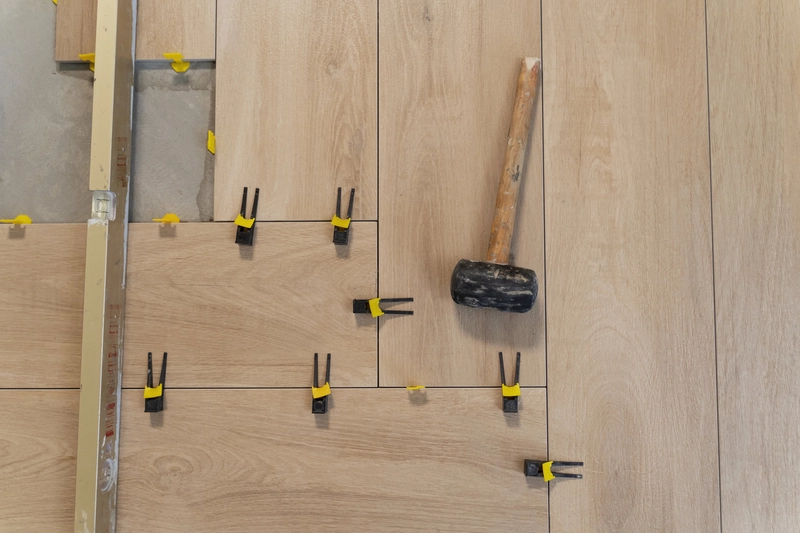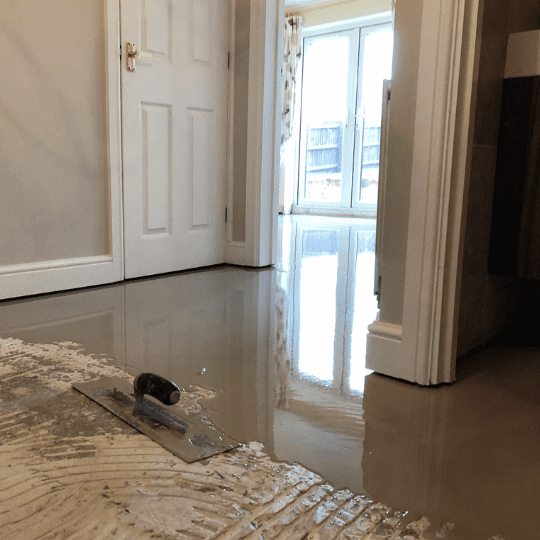Considering an update to your flooring but feeling overwhelmed by the numerous options available? If you currently have tile flooring and are contemplating the installation of laminate flooring, you may be wondering whether it is feasible to install laminate over tile.
This article provides comprehensive insights about laminate flooring on tiles. Equipped with the right information, you will be able to make an informed decision that aligns with your style and requirements. Let us proceed with the discussion.
Can You Put Laminate Over Tile?
The question of whether you can put laminate flooring over tile surfaces is one that many homeowners consider during their home renovation projects. Laminate flooring offers an attractive, cost-effective alternative to traditional materials, but the compatibility with existing flooring, particularly ceramic tiles, raises concerns.
Understanding the nuances of laminate installation over tiles can help you decide if this is the right approach for your flooring project. In this article, we will explore the feasibility of this installation, the necessary preparations, and considerations to ensure successful results.
What Is Laminate Flooring?
Laminate flooring is an engineered product designed to mimic the appearance of hardwood or other materials while providing a durable and cost-effective alternative for residential and commercial spaces. Composed of several layers, the top layer features a photographic image that replicates natural wood or stone, while the underlying layers provide stability, moisture resistance, and sound dampening. This versatile flooring type is ideal for various home renovation projects, thanks to its relatively easy installation process and wide range of styles.
With its durability and aesthetic appeal, laminate flooring has become a popular choice among homeowners and designers alike. The multi-layered composition not only enhances its strength but also allows it to withstand heavy foot traffic, making it suitable for high-use areas such as living rooms, kitchens, and hallways. The vast selection of finishes—from rustic oak to modern stone—ensures that it can fit any decor style.

See product: Elka 8mm V-Groove Country Oak
The Benefits of Laminate Flooring
The benefits of laminate flooring are numerous, making it a preferred choice among homeowners and flooring professionals alike.
Laminate flooring is highly resistant to scratches, stains, and fading, which ensures longevity and maintains the floor’s aesthetic appeal over time. Additionally, its ease of installation allows for quick updates in home renovation projects, while its ability to include a moisture barrier helps safeguard against moisture damage from below.
Furthermore, laminate flooring can enhance sound dampening within a room, creating a more comfortable living environment.
The Drawbacks of Laminate Flooring
While laminate flooring offers many advantages, there are also some drawbacks to consider before making your flooring decision. One of the primary concerns is its susceptibility to moisture damage, especially in areas prone to spills or high humidity.
Additionally, if not installed properly, discrepancies in the subfloor level can lead to problems such as warping or an uncomfortable walking experience. Furthermore, laminate flooring typically lacks the authentic feel and sound of hardwood, which may be a deal-breaker for some homeowners.
The Different Types of Laminate Flooring
There are several types of laminate flooring available, each designed to meet specific aesthetic and functional needs for a variety of spaces. Generally, laminate flooring is categorised into three main types: high-pressure laminate (HPL), direct-pressure laminate (DPL), and waterproof laminate, each varying in terms of durability, installation methodologies, and moisture resistance.
Furthermore, the choice of underlay can significantly affect the performance and comfort of the flooring, making it an important consideration during your selection process.
Can I Put Laminate Over Tile?
Can you place laminate flooring over tile? Installing laminate flooring over tiles is a common practice that can simplify your renovation project and save time and effort. However, it is essential to assess the condition of the existing tiles, as they must be level and free from damage or moisture issues before proceeding.
Additionally, a proper moisture barrier and underlay are vital in ensuring the longevity and functionality of the laminate flooring during this installation process. Consulting with flooring professionals can provide valuable insights and recommendations tailored to your specific situation.
The Factors to Consider Before Installing Laminate Over Tile
Before embarking on the installation of laminate flooring for tiles, several critical factors must be taken into account to ensure a successful outcome. The condition of the existing tiles is paramount; they should be level and adequately secured to the subfloor to prevent future complications. A moisture barrier is essential to safeguard against potential water damage, particularly in damp areas. The overall floor height should also be considered, as it could affect transitions with adjacent rooms or skirting boards.
Proper preparation of the existing tile surface is vital. Any cracks or loose tiles must be repaired or replaced to create a uniform base. Not only does this enhance the stability of the laminate, but it also ensures an aesthetically pleasing result.
Installation success largely depends on selecting the right underlay, which can provide sound absorption and thermal insulation while acting as a moisture barrier.
Understanding the type of laminate chosen for the project is crucial, as different brands and styles may have specific requirements for installation over tiles. Proper acclimatisation of laminate materials before installation can also significantly impact their performance.
- Inspect tiles for cracks and loose areas
- Ensure uniformity of tile surface
- Select appropriate underlay
- Acclimatise laminate materials
By addressing these aspects, one can achieve not only a seamless installation but also lasting durability and enhanced aesthetics in the overall flooring project.
The Steps to Installing Laminate for Tile
Installing laminate flooring over tiles involves a systematic process that ensures both durability and aesthetic appeal. This approach not only enhances the visual attractiveness but also offers a practical solution to outdated tile designs.
The initial step requires thorough preparation, including cleaning the tile surface and assessing for any necessary repairs. Once the tiles are in good condition, a levelling compound may be utilised to address any uneven areas, followed by the installation of a suitable underlay that provides cushioning and moisture protection. The laminate panels can be installed, ensuring proper alignment and allowing for expansion gaps, with transition strips used to seamlessly connect to other flooring types.
To achieve a smooth and successful installation, it’s essential to follow these steps:
- Clean the Tiles: Begin by thoroughly sweeping and mopping the tile floor to eliminate any dust and debris that could interfere with adhesion.
- Inspect for Damage: Check for any cracked or loose tiles. If found, repair these areas before proceeding to ensure a stable base for the laminate.
- Apply Levelling Compound: If the tile surface contains uneven spots, applying a self-levelling compound can help achieve a level foundation for the new flooring.
- Choose the Right Underlay: Selecting the appropriate underlay is crucial; opt for options that provide sound absorption and moisture resistance, particularly in areas prone to humidity.
- Install Laminate Carefully: As you lay each laminate plank, ensure they are locked properly, and remember to leave adequate expansion gaps along the walls to accommodate any changes in the flooring.
- Finish with Transition Strips: Use transition strips at doorways and junctions to create a finished look while also preventing tripping hazards.
By following these practical tips, anyone can successfully install laminate flooring over tiles and enjoy the visual and functional benefits it offers. Using the right underlayment can further enhance the comfort and durability of your flooring.
The Alternatives to Installing Laminate for Tile
When contemplating flooring updates, it is essential to explore alternatives to installing laminate flooring over tiles, considering various flooring options. One of the most straightforward options is to remove the existing tiles entirely, allowing for a fresh start with new flooring materials.
This method can be beneficial if the condition of the tiles is poor or if you wish to install different types of flooring that are not compatible with the tiles. Another option is to consider a floating floor system, which can provide a versatile solution without the need for extensive demolition.
1. Removing the Tile
Removing tiles as part of your flooring project can be a labour-intensive process, but it may yield significant benefits in terms of achieving a clean and level subfloor for your laminate flooring installation. The first step involves assessing the tile condition and using appropriate tools for removal to avoid damage to the underlying subfloor. Once removed, careful preparation of the subfloor is essential to create an ideal surface for laminate installation.
To begin, ensure you have the necessary safety equipment, including gloves, goggles, and a dust mask. This preparation helps mitigate the risks associated with fine dust and sharp debris. Then, gather your tools: a chisel, a hammer, and a high-quality tile scraper. Consulting a flooring expert may also provide additional insight into the process.
- Step 1: Start by loosening the grout around the tiles; this will make them easier to remove.
- Step 2: Use the chisel and hammer to gently lift a corner of a tile and pry it free.
- Step 3: Once you’ve removed the first tile, continue with adjacent ones using the tile scraper to facilitate the process.
After removing all tiles, inspect the subfloor for damage, making necessary repairs to ensure it is ready for the laminate installation. Be sure to remove any baseboards carefully, as they may need reattaching once the new flooring is in place.
2. Using a Floating Floor
A floating floor system presents an appealing alternative when considering laminate flooring installation over tiles, as it allows for the flooring to ‘float’ above the existing surface without the need for glue or nails. This method is particularly advantageous in terms of sound dampening, providing a quieter living environment while also accommodating slight imperfections in the existing tile subfloor.
Floating floors offer flexibility in design and ease of installation, making them a popular choice among homeowners.
One of the significant advantages of a floating floor is its simple installation process. Unlike traditional flooring methods that require extensive preparation and materials like adhesives or fasteners, a floating floor can typically be installed without any specialised skills, enabling homeowners to take on the project themselves. This ease of installation not only saves time but also reduces labour costs.
While floating floors are versatile, it is essential to consider potential drawbacks, such as limited lifespan compared to other flooring types and susceptibility to water damage. Engaging with consulting companies can provide further insights into selecting the best flooring solution.
Benefits:
- Cost-effective compared to glue-down options
- Comfortable underfoot
- Sound-dampening properties
For those looking to install laminate flooring, attention to the moisture levels of the space is crucial, as excess humidity can lead to warping. Utilising a quality underlay can further enhance soundproofing and help achieve a more comfortable walking experience.
The Precautions to Take When Installing Laminate for Tile
When installing laminate flooring over tiles, taking the proper precautions is essential to ensure a successful and lasting installation.
Firstly, checking for levelness in the tile surface is critical, as any uneven areas can result in issues with the laminate’s performance over time. Cleaning the tiles thoroughly is equally important, as dirt and debris can interfere with adhesion and sealing.
Additionally, using a moisture barrier can help prevent moisture damage from affecting the laminate flooring and the tiles beneath it.
1. Check for Levelness
Checking for levelness is a crucial step before installing laminate flooring over tiles, as any discrepancies in the tile surface can lead to uneven wear and potential damage over time. Using a level tool can help you accurately gauge where adjustments may be necessary. If uneven areas are detected, applying a levelling compound can effectively create a smooth and stable base for the laminate installation.
To ensure a successful installation, one can use various tools such as:
- Laser Level: Provides precise readings over larger areas.
- Spirit Level: A traditional tool for determining levelness in smaller sections.
- Measuring Tape: Essential for marking distances and checking high or low spots.
After identifying any discrepancies in the surface, the next steps include:
- Carefully apply a self-levelling compound in uneven spots.
- Allowing adequate time for the compound to cure before proceeding.
This process ensures that the laminate flooring will rest upon a solid and even foundation, which is vital for longevity and aesthetics. A proper levelling compound can help achieve the desired results.
2. Clean the Tile Thoroughly
Cleaning the tiles thoroughly before installing laminate flooring is an essential step that should not be overlooked, as dirt, grease, or other residues can hinder the adhesive properties of the underlay and compromise the final outcome. Inadequate cleaning can lead to significant problems further down the line, including bubbling or peeling of the laminate surface, thereby reducing its lifespan and aesthetic appeal.
Begin by sweeping the area to remove loose debris, followed by mopping with a suitable cleaning solution to ensure a pristine surface. Consulting flooring professionals can also provide guidance on the best cleaning methods specific to your type of tile.
To achieve optimal results, it is crucial to identify the type of tile in your space, as different materials require tailored cleaning approaches. Consider the following effective techniques:
- Porcelain and Ceramic Tiles: Use a mixture of warm water and a few drops of washing-up liquid to scrub the surface with a soft mop, ensuring that you avoid any abrasive materials.
- Natural Stone Tiles: Opt for a pH-neutral stone cleaner to preserve the tile’s integrity and shine. Avoid vinegar or acidic solutions, as they can erode the finish.
- Grout Lines: A toothbrush or a similar brush can be used to gently scrub between tiles, ideally with a baking soda and water paste to lift stains effectively.
After cleaning, allow the surface to dry completely before proceeding with laminate installation, as any moisture can interfere with the adhesive bonding. This preparatory work significantly enhances the longevity and quality of the laminate floor.
3. Use a Moisture Barrier
Utilising a moisture barrier is a critical precaution when installing laminate flooring over tiles, especially in areas where moisture might be an issue, such as kitchens or bathrooms.
The moisture barrier serves to protect the laminate from potential water damage originating from the tile surface, ensuring the longevity and performance of your flooring installation. Selecting the appropriate moisture barrier type based on your flooring type and installation environment can further enhance the effectiveness of this safeguard.
There is a diverse selection of moisture barrier products available that cater to various needs and preferences. Homeowners should consider options such as:
- Plastic Sheets: These are versatile and cost-effective, providing a solid defence against moisture penetration.
- Foam Underlay: This option not only minimises moisture but also offers additional cushioning and sound absorption, enhancing the overall comfort of the flooring.
- Rubber Membranes: These are particularly effective in areas with high humidity, as they provide a robust level of waterproofing.
Each of these products has specific methods of application, from simple roll-out sheets to more complex installation processes, thus allowing for flexibility depending on the project requirements.
Can You Install Laminate Over Different Types of Tile?
Installing laminate flooring over different types of tiles is generally feasible, but there are specific considerations associated with each tile type that must be addressed for a successful installation.
Whether your existing surface is ceramic tiles, vinyl tiles, or porcelain tiles, understanding the unique properties and challenges of each material is crucial. This knowledge will enable homeowners to make informed decisions regarding the installation process, ensuring compatibility and performance of the laminate flooring. Maintaining sound tiles is essential to avoid unnecessary complications during installation.
a. Ceramic Tile
Installing laminate flooring over ceramic tiles is a common practice, but it requires careful evaluation of the tiles’ condition and levelness beforehand. Ceramic tiles are typically durable and can provide a stable base for laminate if they are in good condition. If there are any cracks, loose tiles, or uneven areas, addressing these issues is essential to avoid complications during the laminate installation process.
Before proceeding with installation, homeowners should consider the following factors:
- Assessing Tile Condition: A thorough inspection is necessary to identify any damage. Look for signs of wear, such as chips or cracks, which could affect the integrity of the laminate.
- Levelness: Ensure the tile surface is even. Using a level can help determine if any areas need to be levelled.
- Repair Needs: For tiles that are damaged or not set properly, repairs must be made. This might include re-cementing loose pieces or applying a levelling compound for uneven spots.
Taking these steps ensures a smooth and lasting laminate installation, ultimately enhancing the overall aesthetic and durability of your flooring.
b. Vinyl Tile
Installing laminate flooring over vinyl tiles can be a viable option, provided that the vinyl is securely adhered to the subfloor and remains in good condition. Unlike ceramic tiles, vinyl tiles tend to be more flexible and can sometimes create a less stable base for laminate flooring. Therefore, it is crucial to ensure that there are no bubbles, wrinkles, or peeling edges in the vinyl before proceeding with the installation.
Before diving into the process, homeowners should adhere to several prerequisites to guarantee a seamless installation experience. First and foremost, assessing the condition of the vinyl surface is essential. A sound, even underlay will help maintain the integrity of the laminate flooring over time. It’s important to consult resources for expert advice and product selections that cater to specific needs.
- Check for Stability: Ensure that the vinyl tiles are firmly glued down, as any loose sections can result in unevenness in the laminate.
- Inspect for Damage: Look for cracks or any signs of wear in the vinyl. Damaged areas should be repaired or replaced to prevent complications.
- Clean the Surface: A clean surface is vital for proper adhesion; thus, dirt and debris must be removed before laying down the laminate.
By focusing on these aspects, the installation process becomes not just easier, but also more satisfying in achieving a beautiful, long-lasting flooring solution.
c. Porcelain Tile
Installing laminate flooring over porcelain tiles is often a preferred choice due to the dense and durable nature of porcelain, which typically provides a stable and level base for laminate. It is equally important to ensure that the porcelain tiles are clean and free from any moisture issues, as this can lead to complications further down the line. A moisture barrier should be considered to protect the laminate flooring from any potential water damage.
Beyond just stability, using porcelain tiles as a foundation offers several benefits that can significantly enhance the overall performance and longevity of laminate flooring. To begin with, the hard surface of porcelain contributes to the durability and resilience of the laminate, making it less prone to dents and scratches that would otherwise mar softer substrates.
The thermal properties of porcelain can create a more comfortable living space, as it retains warmth, thereby promoting energy efficiency.
Porcelain tiles are also exceptionally resistant to moisture, which is vital since laminate flooring can be sensitive to humidity. This characteristic helps maintain the integrity of the laminate installation.
It is crucial to ensure the tiles are adequately inspected for cracks or breaks, as this can affect the laminate performance. Adequate preparation and care will ultimately lead to a seamless and aesthetically pleasing installation.
Conclusion
Installing laminate flooring over tiles can be a practical solution for homeowners looking to enhance their spaces without the hassle of removing existing flooring. With proper preparation, including assessing tile condition, ensuring levelness, and utilising moisture barriers, successful installation can be achieved. Whether opting for laminate due to its aesthetic appeal or cost-effectiveness, understanding the nuances of installation can lead to a satisfying flooring project in your home renovation journey.
Achieving a seamless look is essential, and this can be done through careful consideration of the existing tile surface and ensuring it meets installation standards. Homeowners should be mindful of the following key aspects:
- Condition of Tiles: Ensuring that the current tiles are intact and free of breaks to prevent future problems.
- Level Surface: A level base is crucial for laminate to avoid uneven wear and sound issues.
- Moisture Barrier: Utilising a moisture barrier will protect laminate from potential damage, especially in moisture-prone areas like kitchens and bathrooms.
By prioritising these factors, laminate flooring can serve as a durable and stylish alternative, adding warmth and elegance to any room without the stress of extensive renovation, even over vinyl floors.
In summary, installing laminate flooring over tile can be a convenient and cost-effective way to refresh your space without the hassle of removing old tile. With proper underlayment, preparation, and precise installation, laminate flooring can offer a smooth, stylish finish over existing tile while adding warmth and comfort to your room.
However, achieving a professional, long-lasting look requires expertise, and that’s where TEKA Flooring comes in. Our skilled team specializes in quality flooring installation, ensuring every detail is handled with care. From assessing the condition of your tile to expertly fitting each laminate plank, we’re here to make your renovation as smooth as possible. Contact TEKA Flooring today to transform your floors with a flawless, beautifully finished laminate installation.
Read also:

































